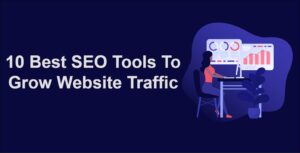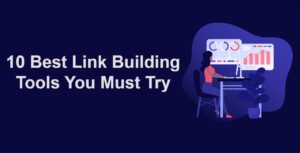Search engine optimization (SEO) is a constantly evolving field, and one of its key components is Off page SEO. While on-page SEO focuses on optimizing your website’s content and structure, off-page SEO involves strategies outside your website to improve its authority and reputation.
Off page SEO is a dynamic and vital aspect of your overall SEO strategy. The latest off-page SEO techniques focus on building authority, credibility, and relevance beyond your website. By strategically implementing these techniques, you can enhance your website’s visibility, drive organic traffic, and improve search engine rankings.
Consistency and a focus on delivering value to your audience are essential to successful off-page SEO. As search engines evolve, staying updated with the latest techniques will help you maintain a competitive edge in the digital landscape.
In this comprehensive guide, we’ll explore the latest off-page SEO techniques that can help boost your website’s rankings and visibility in search engine results.
What is Off Page SEO?
Off-page SEO refers to all the activities that you undertake outside of your website to improve its search engine rankings. The goal is to demonstrate to search engines that your website is authoritative, trustworthy, and relevant to your target audience. Off-page SEO primarily involves building high-quality backlinks, enhancing brand visibility, and establishing your website’s credibility across the web.
The Importance of Off Page SEO
Off-page SEO plays a crucial role in determining your website’s authority and relevance in the eyes of search engines. Some key benefits include:
Higher Rankings: Effective off page SEO can lead to higher search engine rankings, resulting in increased organic traffic.
Improved Authority: Quality backlinks from authoritative websites indicate that your content is valuable and reliable.
Enhanced Brand Visibility: Off page SEO activities expose your brand to a wider audience, increasing brand recognition.
Increased Trust: A strong online presence and positive reputation contribute to building trust with users.
Latest Off Page SEO Techniques
1. High-Quality Link Building
Link building remains a cornerstone of off page SEO. However, focus on quality over quantity. Seek backlinks from relevant, authoritative websites that share a thematic connection with your content. Guest posting, broken link building, and influencer outreach are effective strategies for acquiring quality backlinks.
2. Content Quality and Relevance
Create high-quality, informative, and valuable content that resonates with your target audience. Quality content is more likely to attract natural backlinks. And Creating high-quality content is just the first step; promoting it is equally important.
Getting backlinks through content quality and relevance involves creating high-quality content that naturally attracts links from other websites.
Here’s a step-by-step guide:
Step1: Identify Link-Worthy Topics: Research topics that are relevant to your niche and have the potential to provide value to your target audience. Look for gaps in existing content or trending subjects.
Step2: In-Depth Research: Conduct thorough research to gather accurate and up-to-date information. Use credible sources, statistics, studies, and examples to support your content.
Step3: Create Comprehensive Content: Develop well-structured, informative, and engaging content. This could include articles, guides, infographics, videos, or interactive tools that offer unique insights.
Step4: Originality and Uniqueness: Provide a fresh perspective or unique angle on the topic. Avoid duplicating existing content; strive to add value that sets your content apart.
Step5: Visual Elements: Incorporate visually appealing elements like images, graphs, charts, and videos to enhance the content’s appeal and readability.
Step6: Linkable Assets: Create content that serves as a valuable resource for others. This could include tutorials, case studies, research findings, industry reports, and how-to guides.
3. Influencer Outreach
Influencer outreach is a strategic link-building approach involving relationships with influential individuals or entities in your industry.
These influencers have established credibility and a significant online following.
Leveraging their influence can lead to valuable backlinks and increased visibility for your website. Here’s how influencer outreach helps in link building:
Access to Their Audience: Influencers have a dedicated and engaged audience that trusts their recommendations. When an influencer shares or links to your content, their audience is more likely to engage with it and potentially link to it themselves.
Authority and Credibility: When an influencer promotes your content or website, it adds a level of authority and credibility to your brand. Their endorsement can encourage others to link to your content as well.
Higher Engagement Rates: Influencer-shared content often receives higher engagement rates, leading to more visibility and the potential for others to discover and link to your content.
4. Social Media Engagement
Social media engagement plays a significant role in link building by fostering relationships, increasing content visibility, and encouraging sharing. Here’s how social media engagement contributes to link building.
Relationship Building: Engaging with influencers, industry experts, and other relevant users on social media helps establish connections. Building relationships can lead to collaboration opportunities, guest posting invitations, and natural backlink opportunities.
Building Brand Authority: Consistent engagement on social media helps establish your brand as an authority in your niche. When your brand is seen as trustworthy, others are more likely to link to your content.
Visual Content Attraction: Visual content like infographics, videos, and images often perform well on social media. When others share your visual content, they’re more likely to link back to it.
4. Competitor Research
Performing competitor research for link building involves analyzing your competitors backlink profiles to identify potential link opportunities.
Here’s a step-by-step guide:
Step1: Identify Competitors: Identify your main competitors in your niche or industry. These are websites that rank well for keywords similar to yours.
Step2: Use SEO Tools: Utilize SEO tools like Ahrefs, SEMrush, or Moz to analyze your competitors’ backlink profiles. These tools provide insights into the sources and quality of their backlinks.
Step3: Analyze Backlink Profiles: Study the types of websites linking to your competitors. Look for patterns in terms of authority, relevance, and the types of content that attract backlinks.
Step4: Identify High-Quality Backlinks: Focus on the high quality backlinks your competitors have earned. These could come from authoritative industry websites, blogs, news sources, and reputable directories.
Step5: Explore Linking Content: Examine the content on your competitors’ websites that has attracted backlinks. Identify topics, formats, and approaches that resonate with their audience and generate interest.
Step6: Competitor Content Gap: Look for content gaps where your competitors haven’t covered specific topics. Create comprehensive and valuable content that addresses these gaps.
Step7: Reverse Engineer Outreach: If your competitors have published guest posts or contributed to external websites, reverse engineer their outreach strategy. Identify websites that accept guest posts and pitch your own ideas.
5. Online Reviews and Citations
Positive online reviews and citations from reputable sources can enhance your website’s credibility. Encourage satisfied customers to leave reviews, and ensure your business information is consistent across all online directories.
6. Influential Podcasts and Webinars
Participating in or hosting podcasts and webinars can position you as an industry expert. These platforms provide opportunities to share valuable insights, connect with a wider audience, and gain backlinks.
7. Video Marketing
Video content is highly engaging and shareable. Create informative and entertaining videos related to your niche, and share them on platforms like YouTube. Embed videos on your website to increase engagement.
8. Quora and Forum Participation
Building backlinks through Quora and forum participation involves engaging in meaningful discussions and providing valuable insights while including relevant links to your content.
Here’s how to do it effectively:
Using Quora:
Select Relevant Topics: Identify topics related to your niche on Quora. Search for keywords that align with your expertise and content.
Answer Questions Thoughtfully: Provide in-depth, valuable answers to questions. Address the question directly and offer actionable insights.
Include Relevant Links: Whenever appropriate, include links to your relevant blog posts, articles, or resources that provide more detailed information. Ensure your links add value to the answer.
Contextual Linking: Integrate your links seamlessly within your answers. Explain how the linked content can help users better understand the topic.
Avoid Self-Promotion: Focus on adding value rather than promoting your content. Overly promotional answers may be flagged as spam.
Engage and Interact: Respond to comments and engage in conversations with users who interact with your answers. This increases the visibility of your contributions.
Profile Optimization: Complete your Quora profile with relevant details and expertise. This lends credibility to your answers and encourages users to explore your content.
Participating in Forums:
Identify Relevant Forums: Find active forums within your niche. Popular platforms include Reddit, Stack Exchange, and industry-specific forums.
Provide Valuable Contributions: Engage in discussions by sharing your expertise and insights. Answer questions, provide solutions, and contribute to conversations.
Contextual Linking: Include links to your content when they genuinely add value to the conversation. Explain how the linked resource can help users.
Contribute Regularly: Be an active member of the forum by consistently participating in discussions. Building a reputation within the community enhances your credibility.
Build Relationships: Connect with other active members and establish meaningful relationships. This can lead to collaborative opportunities and organic backlinks.
9. Guest Posting
Guest posting for link building is a mutually beneficial strategy. The host website gains valuable content, while you gain exposure, backlinks, and the opportunity to establish your authority in your niche.
Identify Target Websites: Research and identify websites or blogs that are relevant to your niche and have a good reputation. Look for platforms that accept guest posts.
Study Content and Guidelines: Review the target websites’ content and guest posting guidelines. Understand their content style, tone, and formatting requirements.
Craft High-Quality Content: Create well-researched, original, and valuable content that addresses a specific topic or problem within your niche. Make sure it aligns with the target website’s audience.
Pitch Your Idea: Reach out to the website’s editorial team or content manager with a concise and personalized pitch. Highlight your expertise, proposed topic, and how it adds value to their audience.
10. Infographics and Visual Content
Infographics and visual content are powerful tools for building backlinks because they are visually appealing, easy to share, and provide valuable information.
Here’s how infographics and visual content contribute to backlink building:
Shareability and Virality: Infographics and visual content are highly shareable across social media platforms, blogs, and websites. Their engaging format encourages users to share, increasing the likelihood of backlinks.
Link-Worthy Content: Well-designed infographics provide condensed and visually appealing information. When other websites want to provide their audience with valuable resources, they are more likely to link to your infographic.
Visual Explanations: Complex concepts or data can be simplified and explained through visuals. Websites seeking to explain such topics often link to infographics as a clear and concise reference.
Original Research and Data: Infographics that present original research, surveys, or data findings are valuable to journalists, bloggers, and content creators. They might reference and link to your infographic in their articles.





